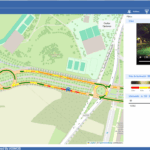During the last years there have been many projects in which the different branches of Artificial Intelligence have been developed for business and leisure uses. In the case of Augmented Reality, we have been able to see technological developments aimed at facilitating access to the product market, such as certain fashion brands that have allowed us to dress virtually before buying an item of clothing online. In Industry 4.0 we have seen applications that allow workers to be educated and trained in risk situations with the security of a simulation but with the proximity of the real environment. In Construction we are already seeing national regulations that require the use of BIM technologies to create a virtual project with great detail before the start of the work. For any user, specialized or not, the recognition of a geographical environment begins to be close by means of data superimposed on images captured from reality.
In the transport sector, the star projects are those related to the development of autonomous vehicles. Practically all the vehicle manufacturing companies have developed, in a more or less successful way, signal detection systems in road infrastructures with the aim of providing vehicle drivers with information on traffic signals, thus helping them to control speed, or reporting the deviation from a given lane by detecting lane markings. These systems that allow information to be offered to the driver have also served as the first step in the development of autonomous driving systems.
However, road safety by the Public Administrations is not left in the hands of advances by vehicle manufacturers and has been faced over time from three different focuses:
- Through the evolution of safety in the vehicles themselves
- Through the evolution of infrastructure security
- Through the development of communications between vehicles, infrastructure managers and vehicle users
The evolution of vehicles in search of greater safety is an intrinsic reality in the automotive sector and all manufacturers seek to differentiate from the rest by achieving a safer vehicle. In recent years, the passive systems such as airbags and restraint systems that increase the safety of people inside the vehicle have evolve to new active systems for monitoring the environment of the vehicle that save lives and increase safety has been very relevant. Safety of those inside and outside of that vehicle. Some of these more advanced systems not only inform the driver but also cause the vehicle to take driving action in specific cases. This is the case of the automatic stop of the vehicle when an imminent risk of being run over is detected.
In Spain there are close to 10,000 run-over accidents a year, of which almost 400 end in the death of the victim. The fact that a few high-end vehicles implement this anti-run over system is not going to significantly reduce the number of accidents. The only way to achieve this would be a massive implementation of the system in all types of vehicles, for which a regulation that requires its installation in the car would be needed. But regulation never keeps pace with the industry, and the auto industry is not focused on pedestrians.
The evolution of infrastructures to achieve an increase in transport safety is a task of the Public Administrations, both in the definition of new public works and in the maintenance and exploitation of the infrastructure already built. During the last few years, the development of traffic control systems has taken a large part of the headlines in the press. On the one hand, due to the need to limit traffic in large cities where pollution levels are very high. On the other hand, because the users of the vehicles have had access to mobile applications capable of helping us and informing us in a much more precise and immediate way than the management authorities themselves. Google Maps and Waze allow us to avoid traffic jams and drive on unfamiliar roads with the same reliability as the most expert driver in the area. These applications, which are very advantageous for users, are seen as a risk by Public Administrations that would prefer to maintain control of traffic flows.
Beyond traffic, in areas where Google has not yet arrived, it is not easy to find applications that warn us of the dangers of losing road adherence, that monitor potholes in the roads, that report on the status of bridges, tunnels or work areas… Although numerous projects have been developed based on the Internet of Things (IoT) with the aim of sensorizing infrastructures, the absence of standards in data protocols and the lack of maturity of IoT technologies do not augur an immediate takeoff of these applications.
In addition, the old trend of installing fixed monitoring points on the roads collides with the new paradigm of ubiquitous computing or ambient intelligence. There is no better monitoring element of a road than the vehicle that drives on it and that is why it can be said that a road will be “more intelligent” the more vehicles that drive on it are able to communicate with the Administration that be in charge.
The development of communications between vehicles, infrastructure managers and vehicle users could be the solution to many of these problems, but vehicle manufacturers are not going to promote it when their interest is to sell more vehicles and not facilitate the improvement of infrastructure management. Roads in Spain may belong to municipalities, provincial councils, autonomous communities, the Ministry of Development… and each entity tries to manage them in the best possible way, in a world where standards are conspicuous by their absence.
The necessary investments will continue to be enormous and difficult to justify as long as the data in the field of transport is not standardized or collaborative systems between multiple administrations do not begin to be created.
Public Administrations should be concerned with ensuring with all their forces the correctly regulated development of new technologies and communication systems used in infrastructures. Phrases heard in some administrations such as “technology has surpassed us”, “the current procedure is not digital”, “we will wait for what companies offer us” or “we do not have resources with digital knowledge” should be accompanied by objectives of digitization in the short and medium term.
In intelligent transport there are still needs for technological advances to achieve more precise and reliable positioning systems, communications with lower latency times (time from when the communication is sent until it is received) or faster and more precise sensors in the control of the state of the road. But the technology will arrive in a very short time, while the standardization and regulation of transport systems depends almost exclusively on the long-term vision of policy makers in the digitization of their own administrations.
IBON ARECHALDE





